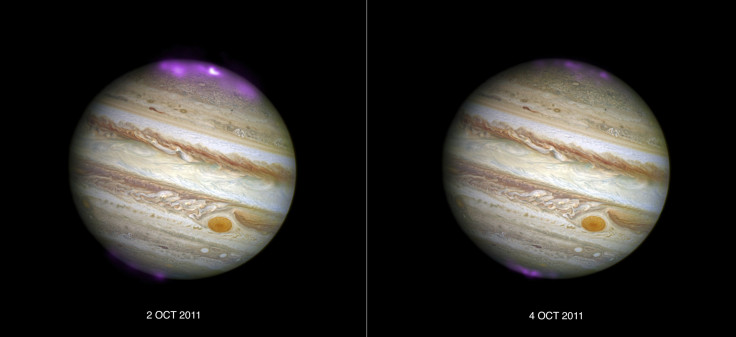NASA’s Chandra X-Ray Observatory Captures Jupiter’s Energetic Aurorae

If there are any sentient beings on Jupiter, and if they are capable of peering through the planet’s dense atmosphere, they would occasionally witness aurorae far surpassing anything ever seen by the denizens of Earth. However, unlike terrestrial northern lights, these Jovian aurorae would only be visible to beings equipped with eyes capable of seeing X-rays.
On Tuesday, NASA released composite images showing Jupiter and its gigantic aurorae. These images, captured by the Chandra X-ray Observatory in 2011, mark the first time that Jupiter’s auroras have been studied in X-ray light.
Terrestrial aurorae are produced when charged particles, known as coronal mass ejections (CMEs), enter Earth’s magnetosphere — a region of space formed by the interaction between stellar winds and the planet’s magnetic field. Once within the magnetosphere, Earth’s magnetic field lines direct the charged particles toward the poles, where they collide with gas atoms in the atmosphere and produce the bright emissions associated with aurorae. Oxygen, for instance, produces the green colors in an aurora while nitrogen causes blue or red colors.
On Jupiter, solar winds carrying the CMEs compress Jupiter’s magnetosphere, shifting its boundary inward by more than a million miles. This gives rise to energetic X-rays in Jupiter’s aurorae, which cover an area bigger than the surface of Earth.
“The impact of the CME on Jupiter's aurora was tracked by monitoring the X-rays emitted during two 11-hour observations. The scientists used that data to pinpoint the source of the X-ray activity and identify areas to investigate further at different time points,” NASA said in a statement released Tuesday.
A paper describing the findings was published Tuesday in the Journal of Geophysical Research — Space Physics.
The latest discovery comes as NASA's Juno spacecraft, launched in 2011, nears Jupiter for the start of its mission. The mission, which will see the spacecraft placed in a polar orbit once it reaches the planet in July, aims to unlock the secrets of Jupiter’s origin, evolution and composition, which scientists hope would help us better understand how the solar system formed.
© Copyright IBTimes 2024. All rights reserved.






















